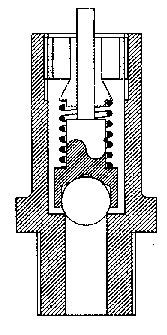
Gordon Smith is no longer providing drawings and springs for his designs but they are now available from Polly Engineering
by Geoff. Baxendale.
A recent talk about safety valves at the club by myself created a lot of interest, and several members have made new valves for their locos. The talk was freely cribbed (with his permission) from the series of articles by Gordon Smith in "Engineering in Miniature" for February, March and April 2001. I was "volunteered" for the talk in the usual Leyland manner, after I had made a very successful valve for my "Ajax".
Gordon's articles came about as a result of him doing a lot of experiments with safety valves in order to find out why so many were failing the steam accumulation test.
Gordon reached the conclusion that "simple" valves, i.e. plain seat and ball type could be made to work quite well if fitted with the correct rate of spring with properly finished ends, and adequately sized vent holes in the adjuster cap. Most seem to be fitted with far too strong a spring, usually cut off from a longer length, and only have small vent holes or slots in the adjuster cap. However the ultimate ability of this type of valve to vent steam, without the pressure rising too much, is limited, even when well designed and well constructed.
The so called "Ross Pop" type of valve (where the ball sits in a counter bore) was also tried and abandoned. (Although it did get rid of the steam!) This was due to the difficulty in manufacturing them, (the counterbore is very critical and needs special tools) and the large hysteresis. i.e the difference between opening and closing pressure.
Finally he decided to adopt the principles employed in a very successful design of hydraulic relief valve he had used in the mining industry, where the ball sits on a plain seat, but in a shroud at the lower end of the spring guide. Gordon has christened this the "Mild Pop" valve. When built to optimised dimensions this has a performance which overcomes the shortcomings of many other designs.
 |
| Mild Pop |
I can thoroughly recommend this design. I grew weary of tapping the pop valves on the Ajax with the shovel to stop me loosing 20 psi, and having them blow off in my face without warning when filling the tanks!
It is important to follow Gordon's dimensions and use the correct spring if you want them to perform to spec. Unfortunately there are mistakes on the drawings in the "Engineering in Miniature" articles, but Polly will supply correct drawings and the correct springs for a small fee. There is a range of designs for engines from three and a half inch up to narrow gauge seven and a quarter types.
 |  |
| Jack's Caledonia. (Digital picture by Fred Wilson) |
Now with SoftPop safety valves. (Photo: Barrie Cook) |
In the left hand picture we see Jack Entwistle's "Caledonia" blowing off, yes, it's in there somewhere, with the safety valves as shown on Martin Evans's drawings. The right hand picture shows it fitted with a pair of Gordon's Mild Pop type.
Thanks to Gordon Smith for allowing me to publish this short summary of his findings on the website.
Gordon Smith is no longer providing drawings and springs for his designs but they are now available from Polly Engineering
| Back to our index page. | Developments over the years. |
| What is Model Engineering? | New Picture Gallery |
| Links to other sites. | Old Picture Gallery. |
| Hints and Tips | Fitting steel tyres to wheels. |